Can people protect as much space as nature needs?
Scientists agree nature must be protected, but how best to do it is up for debate
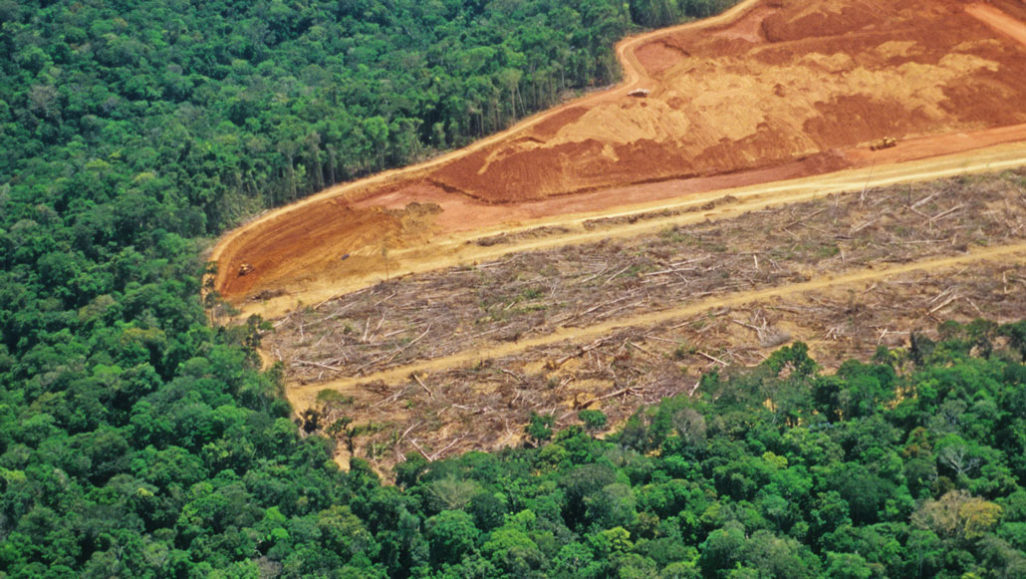
Habitat loss, such as this clear-cutting in the Amazon (shown), is one of the major threats to plant and animal diversity worldwide. Governments are drafting an ambitious new set of conservation targets to safeguard species and prevent further losses.
luoman/E+/Getty Images Plus
For millions of years, giants graced the murky depths of China’s Yangtze River. Known as Chinese paddlefish (Psephurus gladius), they could reach 7 meters (23 feet) in length. The fish used its swordlike snouts to sense electrical perturbations made by smaller prey. It would then snatch them in the dark.
But no more.
The species was declared extinct in 2019. It fell victim to overfishing and habitat loss.
And it is not alone. Nature is in trouble. And few spots are exempt. Species are imperiled from winding rivers to windswept tundra to the dense tropical forests of Borneo.
More and more, habitat loss and human activities threaten the world’s plants and animals. One study estimates a million species face extinction within decades. Their loss is forever. Gone will be 1 million distinct answers to the basic question of how to make a living on planet Earth.
Earth’s life is diverse. But that biodiversity is shrinking. The scale of the potential loss of species has many people and governments worried. Nature has inherent value. But there are direct impacts on people’s lives, too.
The natural world makes Earth livable. It drives key processes. These include cleaning the air, filtering water, cycling carbon dioxide and pollinating crops. To stem this biodiversity loss, governments are working on ambitious plans. Those plans would set aside more space for natural habitats. Nature, after all, needs room to flourish.
One plan now being discussed would protect 30 percent of land and sea across the globe by 2030. That number would reach 50 percent by 2050. Experts hope this will revive ecosystems and safeguard the diversity of Earth’s species.
But is 30 percent — or even 50 percent — enough? And enough for what exactly? Will it slow when and how many species go extinct? Will it protect everything that’s possible to protect?
One place to start is by preserving what’s left. Humans have altered more than three-fourths of Earth’s surface. There are 14 biomes (BY-oams) on land, such as tropical rainforest, tundra and desert. But in eight of those biomes, less than 10 percent of undeveloped wilderness remains. Researchers reported this in a 2016 study in Current Biology.
Many species have already vanished. Besides the Chinese paddlefish there is the brilliantly blue Spix’s macaw. It’s a type of parrot. It has not been seen in Brazil’s forests since 2000. These are just two of many missing species.
At least for marine ecosystems, there’s research to support the 30 percent target as a starting point. There’s less firm evidence for land. But “the scientific consensus is telling us that we need [even] more ambitious targets,” says Oscar Venter. He’s a conservation scientist in Canada. He works at the University of Northern British Columbia in Prince George. Targeting 30 percent of Earth’s land regions for protection by 2030, he says, is not what the best science says. It’s more a reflection of what might be possible to get governments to agree on.
Safe spaces
As of April 2020, nearly 15 percent of land (green) and about 7 percent of the seas (blue) were being given some level of protection. That’s according to data from the U.N. Environment Program World Conservation Monitoring Centre and the International Union for the Conservation of Nature.
Areas under some form of protection in 2020
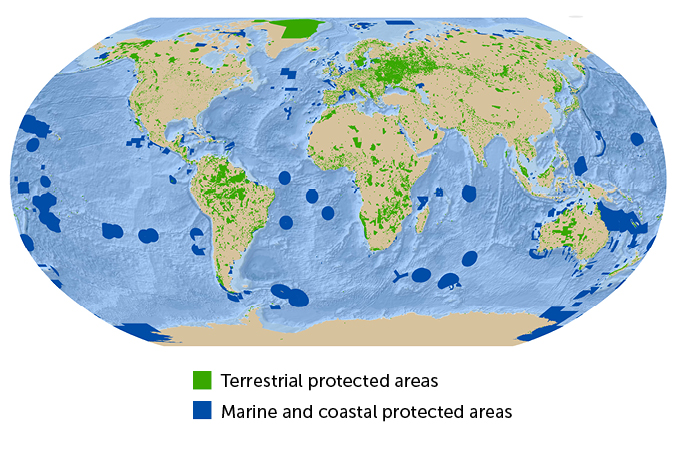
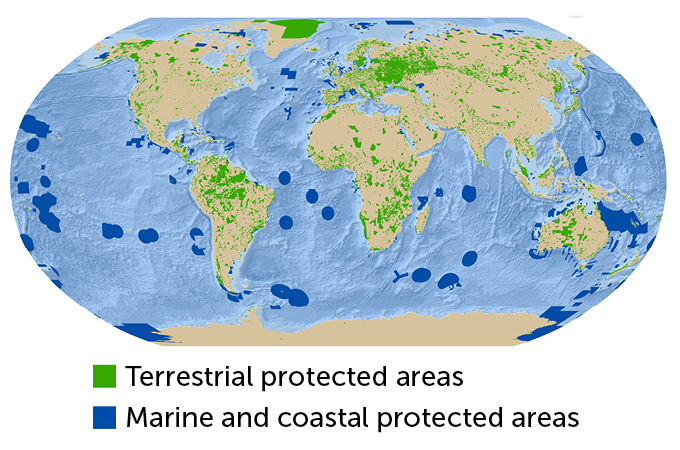
How much is enough?
Deciding how much of nature needs to be protected depends on the goal. That might be keeping a specific animal from going extinct. Or preserving a unique ecosystem. Or ensuring the future of a fish that people eat. Different goals require different types of protected areas.
How big to make a protected area “is important,” says Samantha Murray. “But it’s not the only thing that matters.” Murray is an ocean law and policy expert. She works at Scripps Institution of Oceanography. It’s part of the University of California, San Diego.
When trying to prevent a specific animal species from going extinct, biologists first try to figure out the smallest share of habitat it needs to persist. Wide-ranging species, such as North American caribou, need about 10 percent of their natural range to be protected. Rarer species in microhabitats, such as a single valley or a specific island, “typically need much more,” Venter says. They might even need all of their remaining range to be protected.
Figuring out such numbers is tricky. That’s especially true for little-studied species. Plus, it can be hard to design a protected area that meets the diverse needs of all the species within it.
Another approach focuses on protecting the rare slices of land and sea that brim with huge numbers of species. These are so-called biodiversity hot spots. They include Australia’s Great Barrier Reef and the Amazon River Basin. Parts of the U.S. Great Smoky Mountains are another hot spot. Protecting such areas will save many different animals and plants at once.
Finally, some biologists argue for preserving vast tracts of wilderness not yet altered by human activity. The great boreal forests of Canada and Russia don’t harbor as many species as the Amazon. However, they do hold up to a third of the globe’s terrestrial carbon. That makes them a key part of the Earth process of pulling climate-warming carbon dioxide out of the air. Protecting such areas are crucial for solving both the climate crisis and the biodiversity crisis, says Eric Dinerstein. He’s a conservation biologist at RESOLVE. It’s a conservation group based in Washington, D.C.
Dinerstein and others argue that the situation is now so dire that all approaches are needed to save what’s left. In short, he says: “We need to do it all.”
That same urgency is reflected in the recent flurry of proposals by scientists. Protecting half the planet would save 80 percent of the planet’s biodiversity, concluded biologist E.O. Wilson in his 2016 book Half-Earth. Dinerstein and his colleagues laid out a similar plan in the June 2017 BioScience. It calls for preserving half the planet in a way that covers a diversity of ecosystems.
Venter of the University of Northern British Columbia and his colleagues came up with a bit smaller target. They figure biodiversity can be largely saved with protecting about 44 percent of wild areas. This team arrived at its number in a study posted at bioRxiv.org in November 2019. These researchers tweaked boundaries around existing protected areas. The global patchwork of protected areas they propose is big enough to preserve the 28,594 species of mammals, birds, amphibians, reptiles, dragonflies and crustaceans for which the researchers have data. It also includes some of the world’s areas richest in biodiversity.
Big goals, such as protecting 30 percent by 2030, are important for getting people around the world to act. “But ambitious targets are only good,” Venter says, “if countries are strategic in where they place protected areas.”
Mapping a way forward
One recent science analysis found that 44 percent of land must be protected or soundly managed to end the biodiversity crisis. This map shows existing protected areas (light blue), key biodiversity areas (purple) and wilderness (dark blue). New conservation priorities identified by the researchers’ analysis are in green. The Venn Diagram shows the degree of overlap between each category.
Where protections exist and where they are needed
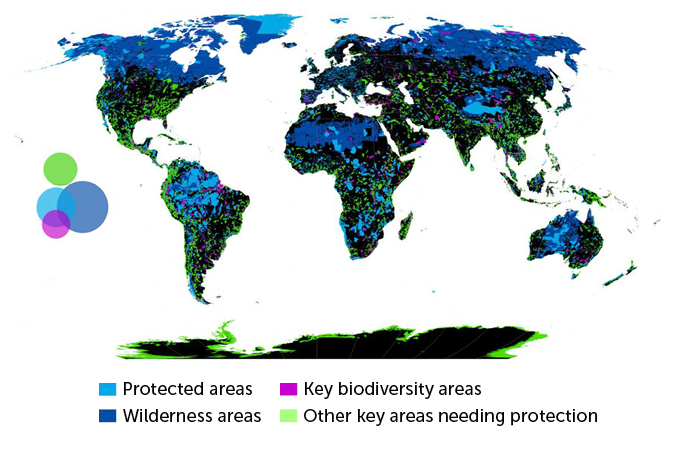
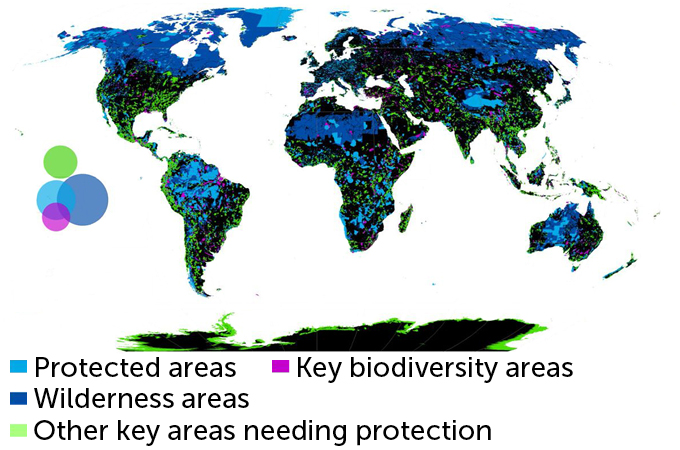
Problems with big targets
Not all biologists even agree that setting such targets is the best way to go. “A big single number [alone] isn’t going to help,” says Stuart Pimm. “And it misses what we need to do to protect biodiversity.” Pimm is a conservation biologist at Duke University in Durham, N.C. It’s better to focus on the most threatened biodiversity hot spots, he argues.
Much of Pimm’s work focuses on connecting forest fragments with natural corridors along which species like to travel. This can increase an animal’s habitat even when protecting lots more land isn’t feasible. Connecting fragmented habitats can boost biodiversity, research shows. And this is true for both animals and plants.
Biodiversity also is not evenly distributed around the globe. Coral reefs, for instance, account for less than 1 percent of the ocean floor. They house, however, more than 25 percent of marine life. So asking all countries to aim for the same goals might be not work well. Some countries may need to protect more than 30 percent of their territory. Others may need less.
“For instance, recent research has shown that we probably need 80 to 90 percent of the Amazon intact,” Pimm says. Otherwise, the rainforest may quickly transform into a drier savannah. And that would threaten the water cycle for all of South America.
Also, countries rushing to meet their goals might only choose to protect what is easiest. “Areas that are too cold, too hot or too remote” to have farms or businesses are easy targets. But they’re not always areas that need protecting most, Pimm says.
The United States could get to 30 percent pretty quickly by preserving sparsely populated deserts or high plains in the West. Most of the country’s biodiversity, though, is in the southeast. For instance, more unique salamander species are crawling around Appalachian streams and lakes than anywhere else in the world. And right now, much of their range remains unprotected. Similarly, protecting most of icy Greenland would meet the European Union’s 30 percent obligation. But little lives there.
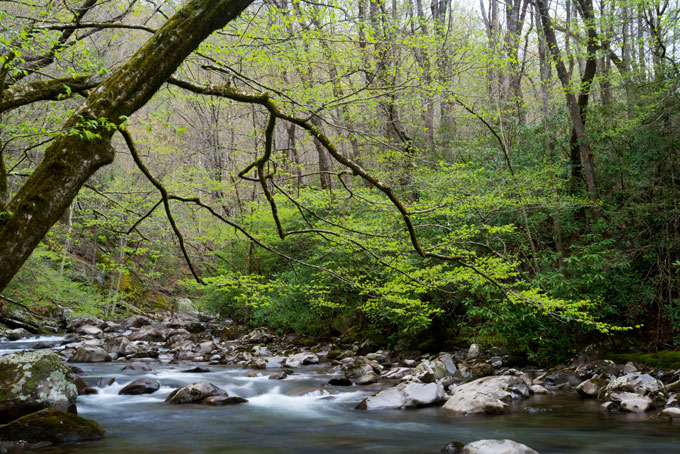
What does protection mean, anyway?
Protected areas will need to be policed. And people who conduct illegal fishing, tree felling, hunting or pollution will need to be prosecuted. Unless that happens, protections don’t work. Conservation goals won’t be met.
Places designated only on paper as protected “can give the illusion of protection where none really exists,” says Murray. She’s the Scripps ocean law and policy expert. “We could create the largest marine protected area in the world. But if we just walk away, it doesn’t do anyone any good.”
Having fully protected national parks across 30 percent of the globe is probably not something that will work, conservationists say. But there are other ways to meet these goals across the land and sea.
“Indigenous lands in Canada are a great example,” Venter says. These lands allow for hunting and gathering activities. The large-scale clearing of habitat, however, is banned. And there is evidence that this approach works. Indigenous lands in Canada, Brazil and Australia had similar, or slightly higher, levels of vertebrate diversity than non-Indigenous protected areas in the same countries. Researchers reported this in November 2019 in Environmental Science & Policy.
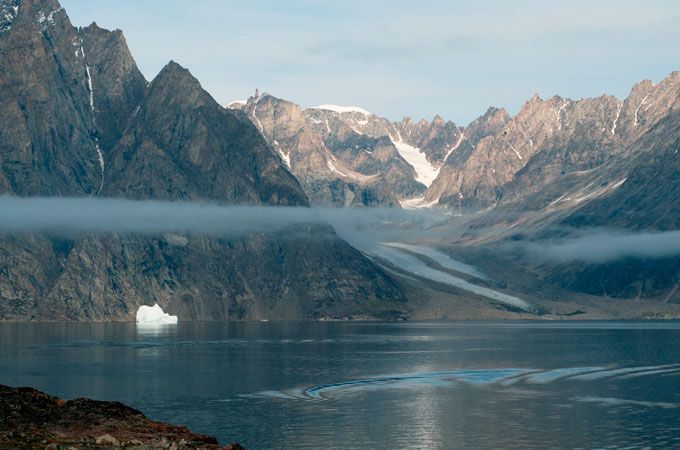
The quarter of Earth’s land now owned, used or occupied by Indigenous communities holds about 80 percent of Earth’s biodiversity. That’s according to a 2008 World Bank report. So empowering these groups to manage their lands could help countries achieve their targets, Venter suggests.
Countries around the world were supposed to meet in China this past fall to work out the details of new conservation targets for the next decade. But like many things in 2020, that meeting got cancelled because of COVID-19. It’s now due to take place later this spring.
Aleksandar Rankovic works at the Institute for Sustainable Development and International Relations. It’s in Paris, France. He hopes the COVID-19 pandemic serves as a wake-up call about the importance of keeping wild places intact. Recent research has linked deforestation to a rise in diseases initially transmitted from animals to people. COVID-19 is one such disease.
“The fact that we have a biodiversity-related global pandemic … is quite powerful as a symbol,” he says. Having governments reach a deal about how much to conserve “could be a big moment” in preventing a global extinction crisis.







